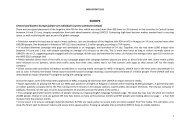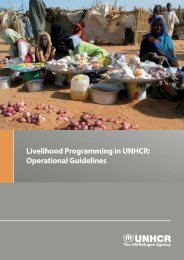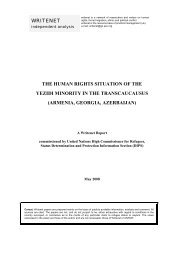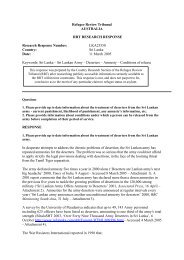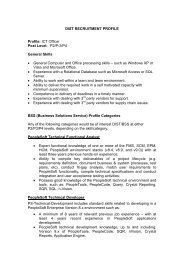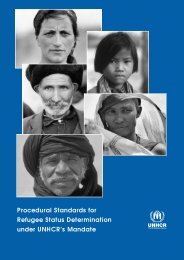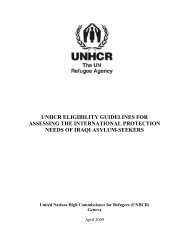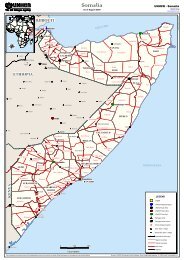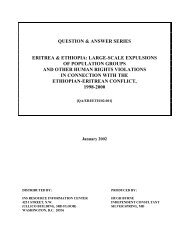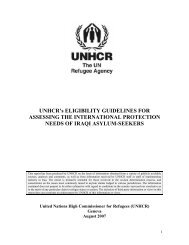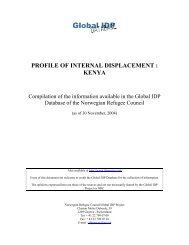CONCLUSIONS ADOPTED BY THE EXECUTIVE ... - UNHCR
CONCLUSIONS ADOPTED BY THE EXECUTIVE ... - UNHCR
CONCLUSIONS ADOPTED BY THE EXECUTIVE ... - UNHCR
You also want an ePaper? Increase the reach of your titles
YUMPU automatically turns print PDFs into web optimized ePapers that Google loves.
2004 (Executive Committee—55 th Session)<br />
(a) Notes that mass influx is a phenomenon that has not been defined, but that, for the purposes of this<br />
Conclusion, mass influx situations may, inter alia, have some or all of the following characteristics: (i)<br />
considerable numbers of people arriving over an international border; (ii) a rapid rate of arrival; (iii) inadequate<br />
absorption or response capacity in host States, particularly during the emergency; (iv) individual asylum<br />
procedures, where they exist, which are unable to deal with the assessment of such large numbers;<br />
(b) Recognizes the differing capacities of States to contribute to resolving mass influx situations;<br />
commends the significant contributions made by countries of first asylum, particularly those in the developing<br />
world and those faced with protracted refugee situations; and stresses the value of action by States, <strong>UNHCR</strong> and<br />
other actors to share the burden and responsibility of countries of first asylum and to strengthen capacities for<br />
the protection of refugees in such host countries;<br />
(c) Encourages all States to continue their efforts to tackle the root causes of, and seek durable solutions<br />
for refugees in, mass influx situations, including through heightened international efforts in the field of conflict<br />
prevention and resolution, poverty alleviation and promotion of respect for human rights and fundamental<br />
freedoms;<br />
(d) Emphasizes the importance of efforts to mainstream gender and age concerns into responses to every<br />
stage of a mass influx from programme development and implementation to monitoring and evaluation, so as to<br />
ensure that the particular protection needs of refugee women, refugee children and older refugees, including<br />
those with special protection concerns, are effectively addressed, inter alia, through registration in principle on<br />
an individual basis, full and equal participation in matters affecting them, protection from sexual and genderbased<br />
violence and military recruitment, and maintaining family unity wherever possible;<br />
(e) Notes the importance of the development by potential host States and <strong>UNHCR</strong>, as well as other<br />
relevant humanitarian organizations, with support by the international community, of emergency preparedness<br />
and response strategies in anticipation of situations likely to lead to a mass influx;<br />
(f) Acknowledges the need for consultations on the international response to a mass influx situation with a<br />
view to developing appropriate international responses, including arrangements among States, regional and<br />
international organizations and, where applicable, financial institutions, as a clear sign of international solidarity<br />
and in the interest of protecting refugees;<br />
(g) Recommends that such consultations should seek to develop, as early on in a crisis as possible, a<br />
comprehensive plan of action, including within the Convention Plus context, that includes arrangements on a<br />
bilateral or multilateral basis to apportion burdens and responsibilities in response to specific mass influx<br />
situations;<br />
(h) Notes further that such consultations could be convened by the High Commissioner, consistent with the<br />
Statute of the Office, through a request by a country exposed to a mass influx or on an ex officio basis, to<br />
examine options appropriate to the particular circumstances of the situation;<br />
(i) Emphasizes that such comprehensive plans of action in a mass influx situation should assist States and<br />
<strong>UNHCR</strong> and other relevant actors in dealing with the immediate humanitarian emergency in a more effective,<br />
predictable and equitable manner, in achieving standards of treatment for those in need of international<br />
protection which fully respect international refugee, humanitarian and human rights law, including in particular<br />
the fundamental principle of non-refoulement, and in identifying and promoting durable solutions adapted to the<br />
particular characteristics of the situation;<br />
(j) Recommends that States, <strong>UNHCR</strong> and other relevant actors, in the emergency response to a mass influx<br />
situation, including when developing a comprehensive plan of action, give consideration to the following burden<br />
and responsibility-sharing arrangements where necessary and appropriate to the situation:<br />
(i) the provision of emergency financial and technical assistance and other forms of support where<br />
necessary, including to humanitarian organizations assisting refugees;<br />
(ii) the implementation, in countries receiving mass influxes, of coordination mechanisms involving<br />
relevant host State authorities, Inter–Agency Standing Committee country team members and<br />
other relevant actors to help ensure an effective international response to the mass influx<br />
situation;<br />
(iii) the establishment, at the international level, of an effective consultation mechanism involving<br />
affected States, other interested States, relevant United Nations system actors and other<br />
international and non–governmental organizations, to begin developing strategies and approaches<br />
to address the refugee crisis, including identifying possible durable solutions, bearing in mind<br />
broader political processes that may be under way to address the mass influx, including its root<br />
166




